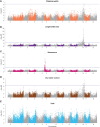The effect of marker types and density on genomic prediction and GWAS of key performance traits in tetraploid potato
- PMID: 38525152
- PMCID: PMC10957621
- DOI: 10.3389/fpls.2024.1340189
The effect of marker types and density on genomic prediction and GWAS of key performance traits in tetraploid potato
Abstract
Genomic prediction and genome-wide association studies are becoming widely employed in potato key performance trait QTL identifications and to support potato breeding using genomic selection. Elite cultivars are tetraploid and highly heterozygous but also share many common ancestors and generation-spanning inbreeding events, resulting from the clonal propagation of potatoes through seed potatoes. Consequentially, many SNP markers are not in a 1:1 relationship with a single allele variant but shared over several alleles that might exert varying effects on a given trait. The impact of such redundant "diluted" predictors on the statistical models underpinning genome-wide association studies (GWAS) and genomic prediction has scarcely been evaluated despite the potential impact on model accuracy and performance. We evaluated the impact of marker location, marker type, and marker density on the genomic prediction and GWAS of five key performance traits in tetraploid potato (chipping quality, dry matter content, length/width ratio, senescence, and yield). A 762-offspring panel of a diallel cross of 18 elite cultivars was genotyped by sequencing, and markers were annotated according to a reference genome. Genomic prediction models (GBLUP) were trained on four marker subsets [non-synonymous (29,553 SNPs), synonymous (31,229), non-coding (32,388), and a combination], and robustness to marker reduction was investigated. Single-marker regression GWAS was performed for each trait and marker subset. The best cross-validated prediction correlation coefficients of 0.54, 0.75, 0.49, 0.35, and 0.28 were obtained for chipping quality, dry matter content, length/width ratio, senescence, and yield, respectively. The trait prediction abilities were similar across all marker types, with only non-synonymous variants improving yield predictive ability by 16%. Marker reduction response did not depend on marker type but rather on trait. Traits with high predictive abilities, e.g., dry matter content, reached a plateau using fewer markers than traits with intermediate-low correlations, such as yield. The predictions were unbiased across all traits, marker types, and all marker densities >100 SNPs. Our results suggest that using non-synonymous variants does not enhance the performance of genomic prediction of most traits. The major known QTLs were identified by GWAS and were reproducible across exonic and whole-genome variant sets for dry matter content, length/width ratio, and senescence. In contrast, minor QTL detection was marker type dependent.
Keywords: GBLUP; GWAS; Solanum tuberosum; genomic prediction; marker density; marker type; tetraploid potato breeding.
Copyright © 2024 Aalborg, Sverrisdóttir, Kristensen and Nielsen.
Conflict of interest statement
Author HK is currently employed by Arla Foods Denmark. The remaining authors declare that the research was conducted in the absence of any commercial or financial relationships that could be construed as a potential conflict of interest.
Figures






Similar articles
-
To be or not to be tetraploid-the impact of marker ploidy on genomic prediction and GWAS of potato.Front Plant Sci. 2024 Jul 30;15:1386837. doi: 10.3389/fpls.2024.1386837. eCollection 2024. Front Plant Sci. 2024. PMID: 39139728 Free PMC article.
-
The Value of Expanding the Training Population to Improve Genomic Selection Models in Tetraploid Potato.Front Plant Sci. 2018 Aug 6;9:1118. doi: 10.3389/fpls.2018.01118. eCollection 2018. Front Plant Sci. 2018. PMID: 30131817 Free PMC article.
-
Genomic prediction of starch content and chipping quality in tetraploid potato using genotyping-by-sequencing.Theor Appl Genet. 2017 Oct;130(10):2091-2108. doi: 10.1007/s00122-017-2944-y. Epub 2017 Jul 13. Theor Appl Genet. 2017. PMID: 28707250 Free PMC article.
-
Physical mapping of QTL for tuber yield, starch content and starch yield in tetraploid potato (Solanum tuberosum L.) by means of genome wide genotyping by sequencing and the 8.3 K SolCAP SNP array.BMC Genomics. 2017 Aug 22;18(1):642. doi: 10.1186/s12864-017-3979-9. BMC Genomics. 2017. PMID: 28830357 Free PMC article.
-
Understanding the interplay of Caesarean delivery and genetic influences on intelligence and anxiety traits in offspring findings from genome-wide association studies.Eur J Obstet Gynecol Reprod Biol X. 2025 Mar 5;25:100377. doi: 10.1016/j.eurox.2025.100377. eCollection 2025 Mar. Eur J Obstet Gynecol Reprod Biol X. 2025. PMID: 40125487 Free PMC article. Review.
Cited by
-
The transmission ability in a population of elite tetraploid potatoes.Plant Genome. 2025 Sep;18(3):e70066. doi: 10.1002/tpg2.70066. Plant Genome. 2025. PMID: 40583826 Free PMC article.
-
To be or not to be tetraploid-the impact of marker ploidy on genomic prediction and GWAS of potato.Front Plant Sci. 2024 Jul 30;15:1386837. doi: 10.3389/fpls.2024.1386837. eCollection 2024. Front Plant Sci. 2024. PMID: 39139728 Free PMC article.
-
Transferability of genomic prediction models across market segments in potato and the effect of selection.Theor Appl Genet. 2025 Aug 20;138(9):219. doi: 10.1007/s00122-025-05004-9. Theor Appl Genet. 2025. PMID: 40833434 Free PMC article.
-
Genetic Foundation of Leaf Senescence: Insights from Natural and Cultivated Plant Diversity.Plants (Basel). 2024 Dec 4;13(23):3405. doi: 10.3390/plants13233405. Plants (Basel). 2024. PMID: 39683197 Free PMC article. Review.
-
Polyploid QTL-seq identified QTLs controlling potato flesh color and tuber starch phosphorus content in a plexity-dependent manner.Breed Sci. 2024 Dec;74(5):403-414. doi: 10.1270/jsbbs.24028. Epub 2024 Nov 23. Breed Sci. 2024. PMID: 39897666 Free PMC article.
References
-
- Bates D., Mächler M., Bolker B. M., Walker S. C. (2015). Fitting linear mixed-effects models using lme4. J. Stat. Software 67. doi: 10.18637/jss.v067.i01 - DOI
LinkOut - more resources
Full Text Sources

